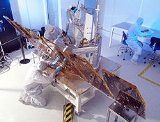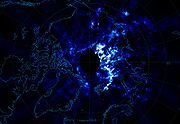
Aeronomy of Ice in the Mesosphere
Encyclopedia
The Aeronomy
of Ice in the Mesosphere
(AIM) is a satellite
to conduct a 26-month study of noctilucent cloud
s (NLCs). It is the ninetieth Explorer program
mission and is part of the NASA
-funded Small Explorer program
(SMEX). On April 25, 2007 AIM was boosted into a 600 km (372.8 mi) high polar orbit
by a Pegasus-XL rocket, which was air-launched from the Lockheed L-1011 Stargazer
aircraft operated by Orbital Sciences.
at altitudes of roughly 80 kilometres (49.7 mi) above the surface, far higher than other cloud
s. The AIM mission will help determine what factors — temperature
, water vapor
, and dust
particles — lead to the formation of these clouds. The clouds seem to be a relatively recent phenomenon: they were first seen in 1885, and lately seem to be occurring more frequently. The clouds always occur during the summer season near the poles and the Northern season always starts around the same time. Scientists have found that the start of the Southern season can vary up to a month however.
, carrying three instruments:
The Cloud Imaging and Particle Size (CIPS) instrument has four camera
s positioned at different angles, which provide multiple views of the clouds from different angles and will allow a determination of the sizes of the ice particles that make up the cloud.
The Cosmic Dust Experiment (CDE) records impacts from cosmic dust particles as they enter Earth's upper atmosphere. The instrument uses fourteen polyvinylidene fluoride
detectors, which emit a pulse of charge when impacted by a hypervelocity dust particle (velocity 1 km/s). A measurement of the value and variability of the cosmic dust input will allow scientists to determine the role the particles have in PMC formation. CDE is a nearly identical replica to the Student Dust Counter on the New Horizons
mission.
The Solar Occultation for Ice Experiment (SOFIE) uses solar occultation to measure cloud particles, temperature and atmospheric gases involved in forming the clouds. The instrument will reveal the mixture of chemicals that prompt NLC's formation, as well as the environment in which the clouds form.

Aeronomy
Aeronomy is the science of the upper region of the atmosphere, where dissociation and ionization are important. The term aeronomy was introduced by Sydney Chapman, and the above definition stems from 1960. Today the term also includes the science of the corresponding regions of the atmospheres of...
of Ice in the Mesosphere
Mesosphere
The mesosphere is the layer of the Earth's atmosphere that is directly above the stratosphere and directly below the thermosphere. In the mesosphere temperature decreases with increasing height. The upper boundary of the mesosphere is the mesopause, which can be the coldest naturally occurring...
(AIM) is a satellite
Satellite
In the context of spaceflight, a satellite is an object which has been placed into orbit by human endeavour. Such objects are sometimes called artificial satellites to distinguish them from natural satellites such as the Moon....
to conduct a 26-month study of noctilucent cloud
Noctilucent cloud
Night clouds or Noctilucent clouds are tenuous cloud-like phenomena that are the "ragged-edge" of a much brighter and pervasive polar cloud layer called polar mesospheric clouds in the upper atmosphere, visible in a deep twilight. They are made of crystals of water ice. The name means roughly night...
s (NLCs). It is the ninetieth Explorer program
Explorer program
The Explorer program is a United States space exploration program that provides flight opportunities for physics, heliophysics, and astrophysics investigations from space. Over 90 space missions have been launched from 1958 to 2011, and it is still active...
mission and is part of the NASA
NASA
The National Aeronautics and Space Administration is the agency of the United States government that is responsible for the nation's civilian space program and for aeronautics and aerospace research...
-funded Small Explorer program
Small Explorer program
The Small Explorer program is an effort within NASA to fund space exploration missions that cost no more than $120 million.- Program history :...
(SMEX). On April 25, 2007 AIM was boosted into a 600 km (372.8 mi) high polar orbit
Polar orbit
A polar orbit is an orbit in which a satellite passes above or nearly above both poles of the body being orbited on each revolution. It therefore has an inclination of 90 degrees to the equator...
by a Pegasus-XL rocket, which was air-launched from the Lockheed L-1011 Stargazer
Lockheed L-1011
The Lockheed L-1011 TriStar, commonly referred to as the L-1011 or TriStar, is a medium-to-long range, widebody passenger trijet airliner. It was the third widebody airliner to enter commercial operations, following the Boeing 747 and the McDonnell Douglas DC-10. Between 1968 and 1984, Lockheed...
aircraft operated by Orbital Sciences.
Noctilucent clouds
The noctilucent clouds AIM is to study, also known as polar mesospheric clouds, occur in the Earth's atmosphereAeronomy
Aeronomy is the science of the upper region of the atmosphere, where dissociation and ionization are important. The term aeronomy was introduced by Sydney Chapman, and the above definition stems from 1960. Today the term also includes the science of the corresponding regions of the atmospheres of...
at altitudes of roughly 80 kilometres (49.7 mi) above the surface, far higher than other cloud
Cloud
A cloud is a visible mass of liquid droplets or frozen crystals made of water and/or various chemicals suspended in the atmosphere above the surface of a planetary body. They are also known as aerosols. Clouds in Earth's atmosphere are studied in the cloud physics branch of meteorology...
s. The AIM mission will help determine what factors — temperature
Temperature
Temperature is a physical property of matter that quantitatively expresses the common notions of hot and cold. Objects of low temperature are cold, while various degrees of higher temperatures are referred to as warm or hot...
, water vapor
Water vapor
Water vapor or water vapour , also aqueous vapor, is the gas phase of water. It is one state of water within the hydrosphere. Water vapor can be produced from the evaporation or boiling of liquid water or from the sublimation of ice. Under typical atmospheric conditions, water vapor is continuously...
, and dust
Dust
Dust consists of particles in the atmosphere that arise from various sources such as soil dust lifted up by wind , volcanic eruptions, and pollution...
particles — lead to the formation of these clouds. The clouds seem to be a relatively recent phenomenon: they were first seen in 1885, and lately seem to be occurring more frequently. The clouds always occur during the summer season near the poles and the Northern season always starts around the same time. Scientists have found that the start of the Southern season can vary up to a month however.
Spacecraft and instruments
The AIM satellite is a 200 kg (440.9 lb), 1.4 m (4.6 ft) by 1.1 m (3.6 ft) spacecraft, powered by two Solar arraysPhotovoltaic module
A solar panel is a packaged, connected assembly of solar cells, also known as photovoltaic cells...
, carrying three instruments:
- Cloud Imaging and Particle Size (CIPS)
- Cosmic Dust Experiment (CDE)
- Solar Occultation for Ice Experiment (SOFIE)
The Cloud Imaging and Particle Size (CIPS) instrument has four camera
Camera
A camera is a device that records and stores images. These images may be still photographs or moving images such as videos or movies. The term camera comes from the camera obscura , an early mechanism for projecting images...
s positioned at different angles, which provide multiple views of the clouds from different angles and will allow a determination of the sizes of the ice particles that make up the cloud.
The Cosmic Dust Experiment (CDE) records impacts from cosmic dust particles as they enter Earth's upper atmosphere. The instrument uses fourteen polyvinylidene fluoride
Polyvinylidene fluoride
Polyvinylidene fluoride, or PVDF is a highly non-reactive and pure thermoplastic fluoropolymer.PVDF is a specialty plastic material in the fluoropolymer family; it is used generally in applications requiring the highest purity, strength, and resistance to solvents, acids, bases and heat and low...
detectors, which emit a pulse of charge when impacted by a hypervelocity dust particle (velocity 1 km/s). A measurement of the value and variability of the cosmic dust input will allow scientists to determine the role the particles have in PMC formation. CDE is a nearly identical replica to the Student Dust Counter on the New Horizons
New Horizons
New Horizons is a NASA robotic spacecraft mission currently en route to the dwarf planet Pluto. It is expected to be the first spacecraft to fly by and study Pluto and its moons, Charon, Nix, Hydra and S/2011 P 1. Its estimated arrival date at the Pluto-Charon system is July 14th, 2015...
mission.
The Solar Occultation for Ice Experiment (SOFIE) uses solar occultation to measure cloud particles, temperature and atmospheric gases involved in forming the clouds. The instrument will reveal the mixture of chemicals that prompt NLC's formation, as well as the environment in which the clouds form.

External links
- AIM home
- SOFIE Instrument and science description, view or download data
- AIM Mission Profile by NASA's Solar System Exploration

